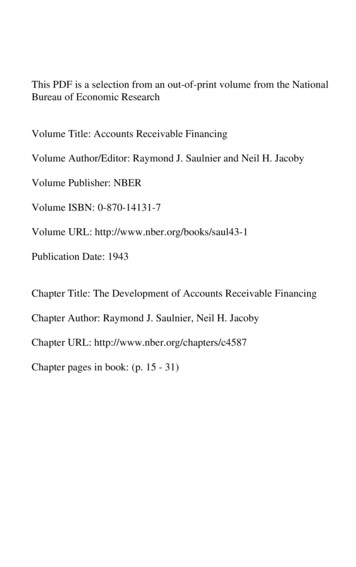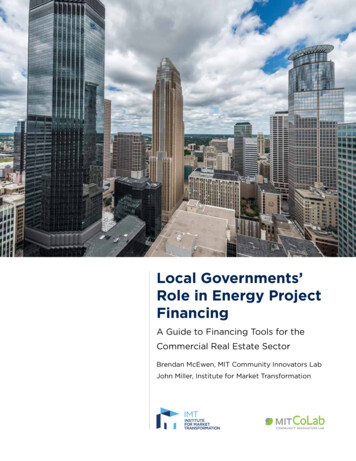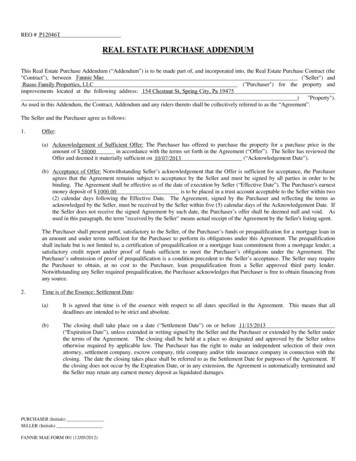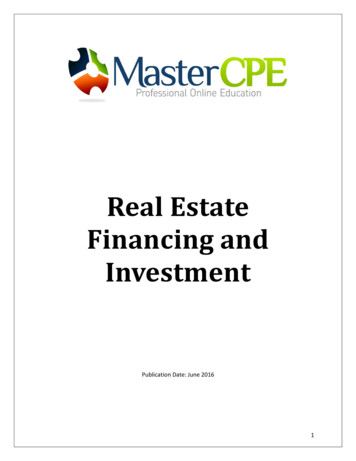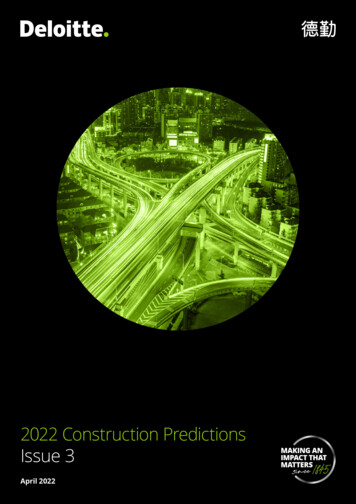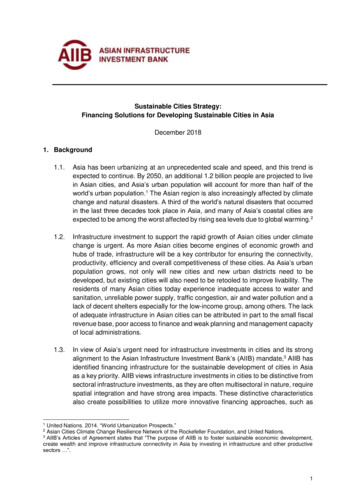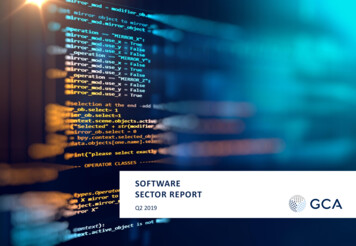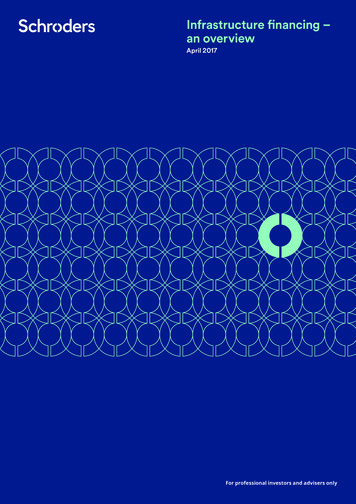
Transcription
Infrastructure financing –an overviewApril 2017For professional investors and advisers only
Executive summaryInfrastructure assets support economic growthby delivering essential services and facilities thatare difficult to replicate or replace. The relativelystable cash flows appeal to equity investorsand also provide comfort to lenders, enablingrelatively high levels of leverage (c.75% debtfinancing, on average).From an investment standpoint, there are manydifferent routes to accessing this market withwide variation in the risk and return profile ofeach.Listed infrastructure equities may at times outperform the broader market inabsolute or risk-adjusted terms but these investments are also exposed to thevagaries of broader market sentiment and returns are likely to remain highlycorrelated with equities. Given elevated equity market valuations, it is optimisticto expect much more than mid single digit returns from listed infrastructureequities at present.Duncan LamontHead of Researchand AnalyticsUnlisted infrastructure equity offers greater diversification potential than thelisted market but high levels of fundraising over recent years alongside too fewassets coming up for sale have pushed prices up considerably. Expected returnsfor core infrastructure investments have fallen from the double digit levels ofthe past to as low as 6-8% now.Infrastructure corporate bonds do not provide any noticeable diversificationbenefits or a structurally better risk/reward trade-off than can be obtained insimilarly rated global corporate bonds. From time to time, they may offer theprospect of better absolute or excess returns than available elsewhere but suchopportunities are tactical rather than structural. A yield of around 3% is slightlyhigher than offered by global corporate bonds but only on a par with bonds ofequivalent credit risk.Clement YongStrategist,Research andAnalyticsPrivate infrastructure debt is a diverse market, covering a range of maturities(5-30yrs), payment terms (fixed/floating), credit risks (investment grade/highyield), regions and sectors, with Europe being the largest market for operationalassets. A 1.0-1.5% credit spread pick-up is available over European publicinfrastructure bonds as well as additional covenants and security not normallyavailable in public markets. However, the trade-off is in liquidity with investorsunlikely to be able to access their money easily, if at all, until their investmentsmature. Credit spreads have held steady at 2% in the European core 5-10year market and investors who are prepared to move further down the riskspectrum into the more specialised high yield market can earn spreads of over4%. However, in the long duration (up to 30 year) sector of the market, excessdemand has pushed up prices, lowered credit spreads and dimmed attractions.Credit spreads here have fallen to 1.5-2.0% and, although these assets continueto serve a purpose from a liability matching standpoint, they now offer far lessappeal on a stand-alone basis.In addition to a higher credit spread, infrastructure debt has also demonstratedlower credit risk than public bonds of similar credit profile. Credit losses onsecured BBB-rated infrastructure debt have been closer to those on securedA-rated non-financial corporate debt than BBB. Furthermore, credit losses on BBinfrastructure debt have been around half that of BB non-financial issues.Schroders Infrastructure financing – an overview1
Infrastructure assetsInfrastructure assets cover a wide variety of areas from airports andtelecommunications networks to hospitals and schools. At a very high level, theysupport economic growth by delivering essential services and facilities that aredifficult to replicate or replace. These assets are often characterised by havinghigh barriers to entry, long economic lives, relatively stable operating cash flows(which are often inflation-linked) and a relative lack of sensitivity to the broadereconomic environment1. Although these assets are not immune to risk, asillustrated, for example, by the profitability of ports and airports, or the usage oftoll roads, that can fluctuate with the economic cycle, they have demonstrateda higher resilience to economic and financial cycles than other assets. Beingessential to the community, and therefore often regulated by authorities,infrastructure assets are, however, more vulnerable to regulatory and politicalrisk.Given their very different cash flow and risk profiles, infrastructure assets areclassified in different categories. A traditional distinction is often made betweenthose assets which are operational (described as ‘brownfield’ projects) and thosewhich are at the construction stage (‘greenfield’ projects).How infrastructure is financedThe stable cash flow profile and asset-backed nature of infrastructure providesa degree of comfort to lenders. As a result, infrastructure financing typicallyinvolves high levels of debt (on average c.75%2 of enterprise value) with theremainder in equity. A typical financing structure is set out in Figure 1.Figure 1: Infrastructure is mainly financed through debtSenior debt 50-75%Junior debt 0-10%Equity 20-40%Source: Schroders. As at January 2017Most infrastructure assets are midcaps, with an enterprise value ranging from 500 million to 2 billion. Equity financing can either be private or public and cancome from a variety of sources including institutional investors, corporations,governments, supranational agencies and capital markets.Debt finance comes in the form of senior or junior debt (including mezzanine).In Europe, 70-80% of financing has historically been provided by the bankingsector with only around 20-30% from capital markets, the opposite to theUS situation. This feature is not specific to infrastructure financing but iscommon across European small and mid-market companies. However, this isprogressively changing in the context of a broader disintermediation of credit inEurope due to the low rate environment and the impact of banking regulation.Yield-hungry institutional investors are increasingly stepping forward to fillthe void and growing in prominence. Capital markets also have a part to playalthough this route typically appeals more to larger repeat borrowers, such asutility companies, than one-off projects, given the additional administrative andfinancial burden associated with this type of finance. EDHEC Infrastructure Institute: Revenue and dividend payouts in privately-held infrastructureinvestments. The analysis is focussed on firms situated in the UK.2 Association for Financial Markets in Europe (AFME)1Schroders Infrastructure financing – an overview2
The menu of infrastructure investmentsFrom an investor’s perspective, exposure to infrastructure can be obtainedin a number of different ways. These are shown below in increasing order ofgovernance burden.Table 1: A variety of ways to gain exposureEquityDebtListed infrastructure equities (a subset Infrastructure corporate bonds (aof global equity markets)subset of the broader corporate bonduniverse)Unlisted equity investments ininfrastructure projects via funds andexternal managersPrivate infrastructure loans via fundswith external managersDirect investment/co-investment inspecific infrastructure projects orcompaniesPrivate infrastructure loans via directlending or segregated accountsthrough an asset managerWithin these categories there are many different flavours of investment acrossthe risk spectrum which can result in a diverse range of return profiles forinvestors.Infrastructure equityInvestors in infrastructure equity, like investors in any other form of equity, arepart owners of a corporation or vehicle. They rank junior to debt holders in thecapital structure which means that debt holders have first claim on the assetsand cash flows generated by the company. If there is anything left over afterthe debt holders have been paid then this value accrues to the equity holders.Debt interest payments are normally fixed in nature (either in absolute termsor relative to some reference rate such as LIBOR) whereas payments to equityholders can be more variable. If the asset is performing in line with expectationsthen the excess above that required for other purposes can be earned by equityinvestors through distributions, including dividends. In contrast, if there areinsufficient earnings to pay debt holders then equity holders can be left withnothing. In return for bearing this risk, equity investors expect a higher returnthan debt holders. Considering the predictability and resilience of infrastructureassets’ operating cash flows, unless the asset is over leveraged with debt, equitydistributions are deemed to be relatively predictable and resilient over economicand financial cycles.Listed infrastructure equityListed infrastructure equity indices can be either regional or global. In additionto traditional corporations such as National Grid (UK), Enbridge (Canada)and Crown Capital (US), some also include Real Estate Investment Trusts(REITs) and Master Limited Partnerships (high-yielding publicly-traded limitedpartnerships popular in the oil and gas sector). Global indices, such as the DowJones Brookfield Global Infrastructure Composite Index (‘DJBGICI’), tend to bedominated by North America (65%) and the utilities and energy sectors (c.85%).Only a few predominantly large assets have access to capital markets whichmeans this only captures a subset of the global infrastructure universe and doesnot reflect the split of infrastructure assets accessible to investors by sectors andgeographies.Schroders Infrastructure financing – an overview3
Since 2002, when the DJBGICI was established, it has generated a higher returnthan the broad equity market with lower volatility. In risk-adjusted terms listedinfrastructure has outperformed the broad market considerably (Sharpe ratioof 0.9 vs 0.5). It has also outperformed all individual sectors of the global equitymarket in absolute and risk-adjusted terms – the utilities sector has returned8.8% a year and earned a Sharpe ratio of 0.6, in comparison. Finally, it tradeson a much higher dividend yield than the broad market (even if Master LimitedPartnerships are excluded then the dividend yield is still more than 1% higherthan the broad market).Table 2: Key characteristics of listed infrastructure equitiesListed global infrastructureGlobal equitiesReturn p.a.12.3%8.5%Volatility p.a.12.8%14.9%Sharpe ratio0.90.5Correlation with globalequities0.8n/aBeta to global equities0.7n/aDividend yield4.2%2.5%Price/earnings multiple34.321.9Price/book multiple2.52.2Source: Datastream, S&P, Schroders. Data 31 December 2002-31 December 2016. Dividend yield andprice/earnings multiple as at 31 December 2016However there are a number of caveats. Firstly, listed infrastructure has beenhighly correlated with broad markets so has offered little diversification.Secondly, infrastructure indices have little or no exposure to financials, a sectorwhich suffered significantly in the financial crisis so the historic comparisonflatters infrastructure. Volatility levels more recently and before the financialcrisis were much more comparable (Figure 2). Consequently, a degree of cautionis required when interpreting these figures. Thirdly, listed infrastructure tradeson more expensive price/earnings and price/book valuation multiples thanthe broader market. This is not a new feature as infrastructure equities haveconsistently traded on a higher price/earnings multiple than the market but it ispresently more stretched than normal (the relative price/book valuation is closeto historic norms).Figure 2: Rolling 24 month volatility%30252015105Listed infraDec16Dec 15Dec 14Dec 13Dec 12Dec 11Dec 10Dec 09Dec 08Dec 07Dec 06Dec 05Dec 040Global equitiesSource: Datastream, S&P, SchrodersSchroders Infrastructure financing – an overview4
Listed infrastructure may at times outperform the broader market in absoluteor risk-adjusted terms but these investments are also exposed to the vagariesof broader market sentiment and returns are likely to remain highly correlatedand volatile compared with other diversifying assets in a portfolio. Against abackdrop where high valuations have driven return expectations for publicequities down to mid single digit levels (or lower), it is difficult to argue thatlisted infrastructure equities are in a position to offer much more.Unlisted infrastructure equityUnlisted infrastructure investments can either be made through funds orsegregated accounts with external managers or by investing directly (includingco-investments). The latter is the cleanest route to obtaining infrastructureequity exposure but requires a significant amount of expertise and governanceoversight which is outside the scope of many institutional investors. Thisroute also typically requires a much larger amount to be committed to eachinvestment which means that only very large investors are likely to havesufficient scale to be able to build a diversified portfolio.A more traditional route for institutional investors to access unlistedinfrastructure equity is through an external manager. These are normallystructured as closed-ended private equity style vehicles with long horizons e.g.10 years. Money is committed up front by investors and drawn down over anumber of years (five or more is not uncommon) while the manager identifiesassets to purchase. Management fees are of the order of 1.5% annually oncommitted capital (including undrawn amounts) plus a 10-20% performance feefor returns in excess of a hurdle rate.Given the illiquid nature of the assets, managers need to realise value forinvestors by exiting these investments at some stage within the fund’s lifetime.Traditional routes include Initial Public Offerings, sales to trade buyers or salesto other financial investors.Realised historic internal rates of return (IRRs) have varied by fund and risklevel but have been broadly 8-10%, net of fees. Rising asset prices and, to alesser extent, refinancing proceeds have been the key drivers of these returns.On a more granular level, IRRs vary by sector, with relatively safe governmentbacked Public Private Partnership (“PPP”) projects and regulated utilities at lowerlevels and businesses in riskier, more economically-sensitive sectors with morevariable cash flows at higher levels.Today, expected returns have declined to 6-8%, net of fees with target cashyields around 5%. These return expectations are slightly more than expectedfrom listed equity markets but less than private equity funds typically target.The declines in return expectations reflect the increases in valuations thathave also been seen in public equity markets but also conditions specific to theinfrastructure sector.In particular, a large volume of money has been raised by infrastructure fundsover recent years – 2016 fundraising set a new all-time high, on top of increasedcapital being made available by direct investors such as large Canadian pensionfunds and Sovereign Wealth Funds (money allocated by these investors isestimated to be as large as the sums raised by fund managers). Alongside,too few assets have come up for sale as deal volumes have flat-lined. Thiscombination has resulted in a doubling in the volume of so-called “dry powder”of funds looking for a home for investment since 2010:Schroders Infrastructure financing – an overview5
Figure 3: Record fundraising and insufficient opportunities have increasedcompetition for assets bn globally1401201008060402002010201120122013Annual capital raised201420152016Dry powderSource: Preqin, 2016The main impact of increased competition has been to put upward pressureon the pricing of the underlying deals. Transaction multiples have been on anincreasing trend since 2012 and are now back at levels not seen since before thefinancial crisis. Expected returns on infrastructure projects have declined.Infrastructure debtAs described earlier, infrastructure projects are normally financedpredominantly by debt, which in the past has been provided mainly by thebanking sector. However, due to the retrenchment of the banking sector,especially in Europe, there is a growing opportunity for institutional investors toaccess this area of the market. Senior infrastructure debt offers a more stable,less glamorous alternative to equity investments and this appeals to certaintypes of institutional investors. In particular, given the long economic lives ofmany infrastructure assets, senior infrastructure debt can be very long dated innature, sometimes inflation-linked, and these long dated cash flows are highlyprized by pension schemes and life insurance companies. The junior parts of thedebt capital structure are normally shorter duration and offer the potential forhigher returns, with higher risk than senior debt but less risk than equity. Figure4 shows the diversity of opportunities that are available across the sector:Figure 4: The wide-ranging characteristics of infrastructure debtLiquidityNatureSectorsGeography ility A-20Y SeniorEURFixedBBB/BBB 10Y Greenfield opeContractedUtilitiesCEEConcessionBBB-7Y – 15YTelecomUKRegulatedBB /BB 7YSocialOECDMerchantNRAUDOtherEmergingSource: Schroders, for illustrative purposes only.Schroders Infrastructure financing – an overview6
Investors can access this sector of the market either through traditionalcorporate bond markets or in private markets. In Europe, the private marketis dominant, accounting for c. 80% of infrastructure debt, therefore offeringa greater diversity of exposures than the corporate bond market. While theunderlying asset characteristics may be similar, the debt-specifics can be quitedifferent:– Credit spread: private debt offers a significant premium to public bonds,estimated between 1.0% to 1.5% for a similar credit profile in Europe– Liquidity: private debt is not readily tradable, as most debt instruments areloans and not securities– Security: while the vast majority of bonds are unsecured, loans are oftensecured, i.e. provide collateral to lenders in the event of a credit event in theform of real assets, shares, bank accounts, etc.– Covenants: private transactions allow investors to negotiate covenants toprovide additional protections and a greater ability to manage risk thanwould be available in public markets– Structuring: bespoke structures can be created for private transactions toadjust the risk profile of the debt instrument to that of the underlying asset,whereas corporate bonds offer less flexibility– Fee income: private lenders are normally paid an arrangement fee when theylend money and exit penalties apply for early repayment. These fees can bematerial.– Fund management fees: the additional work involved in sourcing,transacting, maintaining and managing the risk of a private debt portfolioresults in slightly higher fund management fees than traditional corporatebond funds. However, considering the difference in effort required, thedifference in fees is small e.g. 0.4% is representative for infrastructure debtcompared with around 0.3% for corporate bonds.Infrastructure corporate bondsInfrastructure corporate bonds are a small subset of the broader corporatebond market. In terms of scale, the Dow Jones Brookfield (“DJB”) GlobalInfrastructure Broad Market Index had a market capitalisation of 809 billionat the end of 2016, around 10% of the size of the Barclays Global AggregateCorporate index, less if high yield bonds are included. The DJB index spansinvestment grade (87%) and high yield debt (13%) with an average credit ratingaround BBB. This is slightly poorer than the global investment grade corporatebond market which has a rating of A-. Like the broad market, the largestregional exposure is to US dollar-denominated bonds (63%) which, just like forlisted equities, does not reflect the actual geography and credit diversity of theuniverse of infrastructure assets.At a strategic level, infrastructure corporate bonds have historically offered littlethat could not be easily captured through broad market exposure. Risk-adjustedreturns have been slightly better than the broad market but only in line withcorporate bonds of equivalent credit rating (see table 3, below). Furthermore,yields have been persistently lower than comparably rated corporate bonds dueto greater exposure to the low yielding European and Japanese markets. Creditspreads have varied relative to the market but at the end of 2016 infrastructurecorporate bonds offered a slight pick-up over comparably rated bonds:Schroders Infrastructure financing – an overview7
Figure 5: Infrastructure corporate bonds yield less than global corporatebonds of equivalent rating%108642BBB corpsDec 16Dec 15Dec 14Dec13Dec 12Dec 11Dec 10Dec 09Dec 08Dec 07Dec 060Infra corpsSource: Barclays, S&PAs with infrastructure equities, infrastructure corporate bonds have beenless volatile than market comparators but this is only true because financialsecurities suffered greatly during the financial crisis and the infrastructuremarket has little exposure to this sector. Outside of the height of the crisis,infrastructure bonds have offered no volatility advantage.Furthermore, the correlation between the DJB Index and global BBB-ratedcorporate bonds has been upward of 0.9 over the past 10 years. It is difficultto argue that there has been any noticeable difference between infrastructurecorporate bonds and the bonds that investors may already hold as part of aglobal corporate bond portfolio.Table 3: Key characteristics of infrastructure corporate bondsDJB InfraCorp indexGlobal AggCorpBBB CorpReturn p.a.4.4%3.9%5.0%Volatility p.a.7.3%7.2%7.8%Sharpe ratio0.50.40.5Average credit ratingBBBA-BBBAAverage maturity14.59.09.19.1Duration6.96.66.56.7Yield to worst2.9%2.7%3.1%2.5%Credit spread1.7%1.3%1.6%1.0%A CorpSource: S&P, Schroders, Barclays. Return, volatility and Sharpe ratios calculated over 30 November2006-31 December 2016. All other data as at 31 December 2016.For investors seeking credit exposure to infrastructure in a liquid format,infrastructure corporate bonds may have a certain appeal. However, there areno diversification benefits or a structurally better risk/reward trade-off thancan be obtained in similarly rated global corporate bonds. From time to time,infrastructure corporate bonds may offer the prospect of better absolute orexcess returns than available elsewhere but such opportunities are tacticalrather than structural.Schroders Infrastructure financing – an overview8
Private infrastructure debtPrivate infrastructure debt has been a growing area of the market in recentyears:– On the demand-side, pension schemes, insurance companies and otherinstitutional investors have been forced to broaden their investmenthorizons in the search for yield. Faced with the prospect of having to take onadditional credit risk in this pursuit, it has become increasingly popular toinstead turn to illiquid fixed income asset classes such as infrastructure debt.Here, a pick-up in yield can be earned without a commensurate increasein credit risk. Nothing comes for free, however, and the payback is in arequirement for money to be tied up for longer.– On the supply side, structural issues and regulatory change have led toa pull-back in lending by European banks, as described earlier. Bankingregulation is particularly unfriendly towards long duration or higher riskexposures. These issues and changes have created an opportunity forinstitutional investors to step in and fill the void.This is a global asset class but, within the lower risk brownfield market(operational assets), Europe dominates by some margin (Figure 6). The vastmajority of US infrastructure debt funds concentrate on the constructionstage which has a very different risk/reward profile (projects at this stage donot normally generate any positive cash flows). The remainder of this sectionconcentrates on the European brownfield market.Figure 6: Europe dominates the brownfield marketInfrastructure transactions (2015, bn)604530150GreenfieldNorth ingAsiaLatamMiddle-EastSource: Infradeals, September 2016Note that these figures do not tie up exactly with those in Figure 3 due to differences in sourcesbut this does not impact the conclusions being made. Due to the private nature of the market, suchinconsistencies are inevitable and unavoidable. “Greenfield” stands for new build (equity and debt),“Brownfield” for the acquisition or the funding of new developments of operating assets (equity anddebt), and “refinancing” for the refinancing of operating assets (debt only).Infrastructure debt is a heterogeneous asset class, mirroring the variety of riskprofiles among infrastructure companies. Figure 4 detailed some of the keydifferences and table 4, below, sets out the characteristics of the main investablesectors of the private infrastructure debt market. There is also a small marketfor inflation-linked infrastructure debt (located mainly in the UK where thedemand from investors is higher than in the rest of Europe), which pays a yieldpremium over inflation-linked government bonds. This has largely remainedbank-financed to date but the investable market is expected to grow. As withunlisted infrastructure equity, investments are today typically made via closedended private equity style vehicles, although larger institutions can also lendto specific projects or companies on a direct or co-invested basis or throughsegregated accounts managed by an external asset manager. Investmenthorizons and risk levels vary considerably.Schroders Infrastructure financing – an overview9
Table 4: The private infrastructure debt universeCoreHigherYieldingLong Duration5-105-710-30Fixed/floatingMainly floatingFloating andfixedFixedBonds/loansMainly LoansLoans or BondsBondsRankSeniorSubordinatedSeniorCredit risk (average)[BBB][BB][BBB]Credit spread (basispoints)200400 150-200Annual issuance in Europeand UK ( bn, estimate)50510Maturity (years)Source: Schroders, January 2017, for illustrative purposes only.As a result of the historic bank domination of infrastructure companies’financing, the majority of the market is structured as 5-7 year floatingrate loans. Most are not rated but share characteristics with bonds of lowinvestment grade credit quality, on average. Access is via the secondary loanmarket or on the primary market in the pool of lenders, usually alongside banks.However, given the nature of the infrastructure cash flows themselves, verylong dated (up to 30 year) fixed rate debt is also common, in contrast to thetraditional corporate bond market. This sub-segment is usually structured inthe format of institutional bonds through private placements. Unlike otherinfrastructure debt segments, institutional bonds have characteristics that aremore common to liquid corporate bonds, and more frequently are tending to beunsecured with no financial/maintenance covenants.And a small market for higher yielding opportunities exists for investors whohave the willingness to bear additional credit risk. Given the limited supply offunds in that segment compared to the growing demand from sponsors andborrowers, higher yielding infrastructure debt characteristics are more flexiblethan high yield bonds. They can be structured as floating or fixed rate, loans,notes or bonds, but always have security packages and financial/maintenancecovenants. As such they differ to high yield bonds which do not usually featuresuch protections for lenders.Infrastructure debt has offered a persistent spread pick-up over the publicmarket. Data on pricing is limited given the private nature of the market butFigure 7 shows a selection of representative European private transactions withimplicit investment grade characteristics against a European infrastructurecorporate bond index. On average, private infrastructure debt of this type hasoffered a credit spread of 100-300 basis points over equivalent governmentsecurities over the 18 months to March 2017, 50-200 basis points more thanpublic bonds. However, this varies from transaction to transaction dependingon risk, covenants, maturity, complexity and other characteristics. Some of thispick-up also represents an illiquidity premium – compensation that investorsdemand for the lack of liquidity in infrastructure debt. Ideally we would beable to isolate this factor by comparing a private infrastructure bond with anotherwise identical public market bond. However, given the unique terms foreach infrastructure transaction, this is not possible. The best we can do is to saythat it is likely to be a factor.Schroders Infrastructure financing – an overview10
Figure 7: Spread pickup over listed infrastructure bonds35030025020015010050Schroders EuropeanInfra Corporate Bond IndexMar 17Jan 17Nov 16Sep 16Jul 16May 16Mar 16Jan 16Nov 15Sep 150Representative Private EuropeanInfra Debt TransactionsData relates to bonds or transactions with explicit or implicit investment grade characteristics.Sources: Schroders, Bloomberg, InfraDeals database, The Private Placement Monitor, Cbonds.com,Bank of American Merrill Lynch (“BoAML”). Index is BoAML European infrastructure corporate bondindex, developed with Schroders (proprietary index).As with infrastructure equity, demand for senior infrastructure debt has recentlyoutpaced supply, leading to a compression in the additional credit spreadoffered over public markets. This is particularly true within the long durationsector where demand has been strong from European insurers, due to thefavourable capital treatment that infrastructure debt can obtain under SolvencyII (qualifying debt is entitled to a 30% reduction in its capital requirementcompared with equivalent rated public corporate bonds). Current spreads of150-200 basis points in this sector are
Table 2: Key characteristics of listed infrastructure equities Listed global infrastructure Global equities Return p.a. 12.3% 8.5% Volatility p.a. 12.8% 14.9% Sharpe ratio 0.9 0.5 Correlation with global equities 0.8 n/a Beta to global equities 0.7 n/a Dividend yield 4.2% 2.5% Price/earnings multiple 34.3 21.9 Price/book multiple 2.5 2.2
